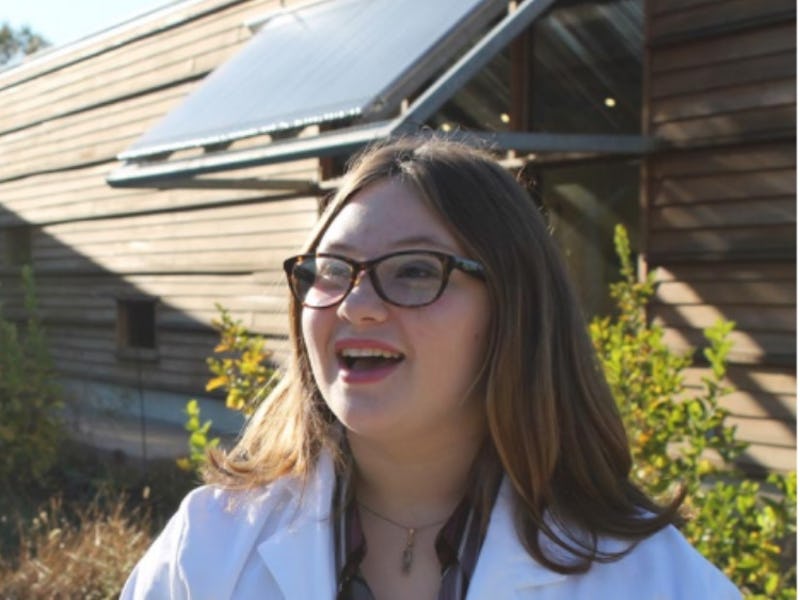New Jersey Teen Is Saving Her State's Water, One Preserved Fish at a Time
"I think if you just get through to one person, it's all worth it."

Most people who discover that a natural gas pipeline is about to built through their local nature preserve are too intimidated by the unstoppable forces of big energy, lobbyists, and the promise of local jobs to do anything about it. Fortunately for the people of Princeton Ridge, New Jersey, Sonja Michaluk is not most people.
By the time she was ten, Michaluk, who grew up splashing in the tadpole-laden ponds of the 500-acre Washington Crossing State Park, already understood the local ecosystem was too important to sacrifice. At that young age, she already had four years of environmental monitoring experience behind her, so she had no problem presenting her own data on the health of streams at public meetings. She wanted it to be as clear to the community as it was to her just how much pipelines affected the ecosystems of neighboring streams.
Now, Michaluk is a 15-year-old Hopewell Valley Central High School junior who’s won the President’s Environmental Youth Award for an innovative invention designed to monitor the health of water systems. She has not stopped collecting data because she understands its importance in shaping public opinion and policy, perhaps as a result of her early success with Washington Crossing.
“I really want science to be the language of debate,” Michaluk tells Inverse. “The more data, the better.”
Michaluk in her lab.
Back when she was presenting her findings in a room packed full of individuals debating the future of the park, a fellow presenter admitted to Michaluk she was the only one who actually brought data. Ultimately, the pipeline’s path was diverted under the stream instead of through it.
That rush of using science to inform and protect is still a cornerstone to her life. The invention for which she won the PEYA award greatly advanced a technique used to monitor the health of local waterways. Specifically, it improved the process of DNA barcoding, a technique used to identify organisms on a species level — which is a key part to figuring out which kinds of animals can withstand polluted waters and which are not.
Creatures like macroinvertebrates — invertebrates you can see without a microscope, as she wrote in in her 2016 entry in the Encyclopedia Britannica (yes, she wrote the entry!) — can reveal the health of a body of water through their pollution tolerance levels. “I’ve definitely noticed in some streams I’m monitoring, a decrease in low-tolerance macroinvertebrates and an increase in high-tolerance macroinvertebrates with an increase in nutrient pollution,” Michaluk explains.
Her invention, which she developed in about eight months using an old DVD player and multimeter, is a way of preserving these specimens safely between the time they’re collected and the time they can be identified in the lab. Improving the transportation process of specimens, she explains, makes analysis far more consistent and accurate. Thanks to her device, there’s a lower risk that DNA from rare specimens will degrade, and researchers can transport their samples safely from farther away.
Michaluk built her device using recycled materials, like an old DVD player and multimeter.
It’s perhaps not surprising that Michaluk’s ability to connect with nature translates to her ability to connect others to it as well. She has taught kids about waterway health while donning a silicone mermaid tail and encouraged adults not to hit copperhead snakes with a shovel, understanding with every step that making better decisions about the environment starts with care.
“I’ve tried to coach people who are terribly afraid of snakes and get them to, ‘Aah, snakes!,’ to ‘Okay, I can tolerate them,’ because if they notice that the species is endangered, they’re more likely to protect it,” says Michaluk. “I think if you just get through to one person, it’s all worth it.”
Considering her current plans, she’ll reach far more than one person. Partnered with the Watershed Institute, Michaluk is now working on building a microbiology lab in her local community. In addition to setting up the lab, she’ll also be writing the curricula, which will join her previous work, like “Happy Herpatology” for young kids. With facilities like these, she hopes to help expand the capabilities of local research and the number of people who can take part in it.
“In five years? I’d love to study biology or genetics. And definitely get a Ph.D., of course.” says Michaluk. “After college, I see myself running a laboratory or research center and make an impact. I really see that data speaks.”